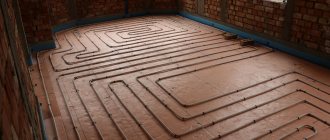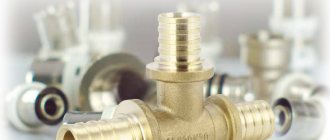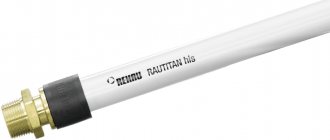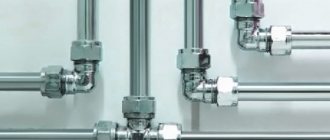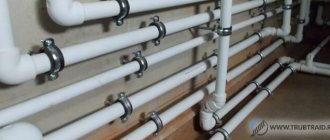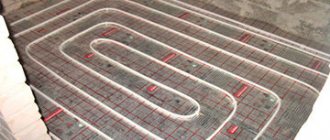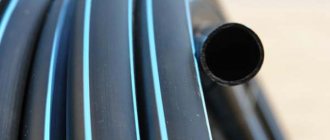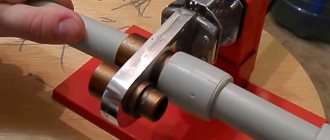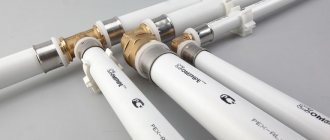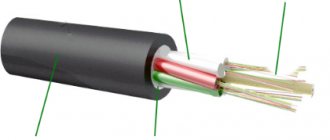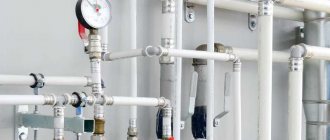Modern chemical technologies make it possible to obtain material for the production of pipes – cross-linked polyethylene – from ethylene gas. The production process is multi-stage. The technical characteristics of the final product are such that they allow the use of cross-linked polyethylene pipes for the installation of not only water pipelines, but also individual heating systems.
No. 1. Production Features
If ordinary polyethylene (a polymer consisting of carbon and hydrogen atoms) is treated in a special way, some of the hydrogen atoms are separated, leading to the formation of a new bond between the carbon molecules. The process of making these additional carbon bonds is called cross-linking . Polyethylene is exposed to various substances and methods, so the degree of cross-linking may vary. The optimal indicator is 65-85%.
Cross-linking allows you to improve the properties of polyethylene: increased resistance to high temperatures, improved flexibility, wear resistance, and the ability to self-heal after mechanical stress. The crosslinking process was developed by the Swedish chemist T. Engel in 1968, but underestimated his invention, considering it uncompetitive. The patent was bought from him by the company WIRSBO, which was the first in the world to begin the industrial production of cross-linked polyethylene (PEX) pipes and is still a leader in this field. Such products did not immediately appear on the domestic market, but now they are extremely popular.
A PEX pipe usually consists of three layers : inside there is cross-linked polyethylene, outside there is an oxygen-protective layer, they are connected with glue. 5-layer pipes on sale . They also have a layer of glue and cross-linked polyethylene on top of the oxygen-protective layer.
No. 2. PEX pipe joining method
The most important parameter when choosing cross-linked polyethylene pipes is the crosslinking method used by the manufacturer. The number of additional connections formed, and therefore the performance of the product, depends on it.
To form additional bonds (bridges) in polyethylene, the following crosslinking methods are used:
- peroxide cross-linking, such pipes are marked PEX-A;
- silane cross-linking, PEX-B;
- radiation cross-linking, PEX-C;
- nitrogen cross-linking, PEX-D.
PEX- A pipes are produced by heating raw materials with the addition of peroxides. The crosslinking density of this method is maximum and reaches 70-75%. This allows us to talk about such advantages as excellent flexibility (maximum among analogues) and memory effect (when unwinding the coil, the pipe almost immediately takes its original straight shape). Kinks and creases that may appear during the installation process can be corrected by slightly heating the pipe with a hair dryer. The main disadvantage is the high price, since peroxide cross-linking technology is considered the most expensive. In addition, during operation, chemicals are washed out, somewhat more intensely than in other PEX pipes.
PEX- B pipes are produced in two stages. First, organic silanides are added to the raw material, resulting in an unfinished pipe. After this, the product is hydrated, and eventually the crosslink density reaches 65%. Such pipes are notable for their low price, they are resistant to oxidation, and have high pressure values at which the pipe ruptures. In terms of reliability, they are practically not inferior to PEX-A pipes: although the percentage of cross-linking here is lower, the strength of the bonds is higher than with peroxide cross-linking. Among the disadvantages , we note their rigidity, so bending them will be problematic. In addition, there is no memory effect, so the original shape of the pipe will not be restored well. When creases appear, only couplings will help.
PEX- C pipes are produced using the so-called. radiation cross-linking: polyethylene is exposed to electrons or gamma rays. The production process requires careful control, because the uniformity of cross-linking depends on the location of the electrode relative to the pipe. The degree of crosslinking reaches 60% , such pipes have good molecular memory, they are more flexible than PEX-B, but during operation cracks can form on them. Creases can be corrected only with couplings. In Russia, such pipes are not widely used.
PEX- D pipes are produced by treating polyethylene with nitrogen compounds. The degree of cross-linking is low, about 60% , so in terms of performance, such products are significantly inferior to their analogues. The technology is virtually a thing of the past and is hardly used today.
PEX-EVOH pipes on sale . They differ not in the method of crosslinking, but in the presence of an additional external anti-diffusion layer of polyvinylethylene, which further protects the product from oxygen entering the pipe. According to the stitching method, they can be anything.
PEX- A pipes are considered the highest quality , but their high cost forces many to use PEX-B pipes. These two types of products are most widespread on the market, and the choice between them depends on the budget, personal preferences and the characteristics of the pipeline that needs to be built with their help.
Do not confuse cross-linked polyethylene pipes with:
- pipes made of low-pressure polyethylene , they can withstand temperatures of no more than +400C and are suitable only for cold water supply systems;
- pipes made of uncrosslinked Pert ; they lack intermolecular bonds; instead, polymer chains intertwine and interlock. Such pipes have recently appeared on the market and can withstand temperatures up to +700C;
- pipes made of heat-resistant polyethylene. They are also able to withstand high temperatures (due to the introduction of heat-resistant additives into the polymer composition), but will not be able to operate at high temperatures and other loads for as long as PEX pipes.
Polyethylene pipe PE-RT
An innovative development in the production of pipes has become products made from polyethylene PE-RT (polyethylene with increased heat resistance - “Polyethylene of Raised Temperature Resistance”). By and large, this type of polyethylene cannot be fully called a cross-linking product. The fact is that the initial granular raw materials from which products are made have stable intermolecular bonds, and even more branched than those of PEX.
The process of creating PE-RT became possible with the development of technology that makes it possible to control the processes of spatial formation of macromolecules. These developments make it possible to create materials whose structure will correspond to precisely specified parameters. This opens up opportunities to focus on a certain property of materials.
Scheme of the molecular structure of heat-resistant polyethylene PE-RT.
The abundance of intermolecular bonds makes the material resistant to internal and external loads, eliminating the appearance of cracks or breaks during strong bending. Despite aggressive influences, PE-RT, unlike PEX, always retains its thermoplasticity. Therefore, the connection of pipes of this type can be made not only using crimp fittings, but also using welding technology. This simplifies and reduces the cost of installation, and high-quality welding ensures the highest reliability of the joints, and therefore the heating system as a whole.
Considering the advantages of PE-RT, we can conclude that it is confidently displacing previously widely used PEX products from the market. These advantages include the following qualities:
- The manufacturing technology of PE-RT is much simpler, since it does not require an intermolecular cross-linking cycle. All the necessary properties to achieve the required parameters are already included in the semi-finished raw material. Interestingly, waste heat-resistant polyethylene can be recycled without losing any of the original qualities of the product.
- The durability of PE-RT pipes is estimated at 50 years or more.
- This type of pipe, due to its plasticity and strength, is able to withstand several freezing cycles along with the coolant, without losing its original qualities and depressurizing the heating system.
- PE-RT pipes can be repaired, which is impossible for PEX analogues.
- Due to its structure, the material perfectly absorbs the sound of coolant flowing through it. In addition, due to their plasticity, they do not produce squeaks in the underfloor heating system in the apartment, which is sometimes the problem with PEX pipes.
PE-RT is used both for the production of metal-plastic pipes and those made only from this polymer.
The structure of a metal-plastic pipe made on the basis of PE-RT polyethylene.
Both the metal-plastic version and pipes made of PE-RT polyethylene have higher technical and operational characteristics than their PEX counterparts.
Many PE-RT pipes, if they do not have an aluminum layer, are equipped with special oxygen barriers. Manufacturers use their own developments as this layer, for example EVON or OXYDEX.
The structure of the pipe is made of heat-resistant polyethylene, equipped with a special EVON barrier against oxygen diffusion
As an example, we can give a table with the main technical and operational characteristics of PERT-AL-PERT pipes from the rather popular COMPIPE production brand:
| Name of parameters | Indicators | |||
| Outer diameter, mm | 16 | 20 | 26 | 32 |
| Wall thickness, mm | 2 | 2 | 3 | 3 |
| Coil length, m | 200 | 100 | 50 | 50 |
| Pipe weight (g/linear m) | 113 | 149 | 264 | 331 |
| Pipe cavity volume (l/linear m) | 0.113 | 0.201 | 0.314 | 0.531 |
| Minimum bending radius, mm | 45 | 60 | 95 | 125 |
| Outer layer (material) | PE-RT (polyethylene with increased heat resistance) | |||
| Inner layer (material) | PE-RT (polyethylene with increased heat resistance) | |||
| Aluminum layer connection method | TIG butt welding | |||
| Operating temperature, ˚С | 70 | |||
| Maximum temperature, ˚С | 95 | |||
| Maximum pressure, bar | 10 | |||
| Linear expansion coefficient, (К⁻¹) | 2,3×10⁻⁵ | |||
Prices for PE-RT pipes
PE-RT pipes
No. 3. Advantages and disadvantages of PEX pipes
It is difficult to call cross-linked polyethylene pipes a unique and revolutionary product, but the material actually has many advantages:
- maintaining performance within a wide temperature range. The pipe will withstand a short-term decrease in temperature to -500C and an increase to +1200C , the material melts only at a temperature of +1500C. Remember that it is optimal to operate pipes at a temperature of 0...+950C - if the product is often exposed to critically high or low temperatures, this will affect its durability;
- resistance to pressure changes , the ability to withstand pressure of 4-10 atm (the specific value of the maximum pressure depends on the type of pipe);
- flexibility . In pipes with different crosslinking methods, the flexibility indicators differ, but, in general, remain high;
- high strength, wear resistance;
- durability up to 50 years , subject to proper installation and operation;
- resistance to corrosion , bacteria, fungi, and aggressive chemicals, so the material can easily withstand the effects of alkalis and acids dissolved in water;
- the smoothness of the walls ensures excellent hydraulic performance, which does not deteriorate over time, since growths on the walls practically do not form;
- safety. PEX-A and PEX-B pipes do not emit any toxic substances, but PEX-C pipes are prohibited for use in some European countries;
- elasticity . If the water inside the pipe freezes, it will not burst;
- molecular memory (in some types of PEX pipes), which allows the material to restore its original shape;
- the material perfectly absorbs noise, which ensures comfortable operation;
- light weight (a linear meter weighs 0.1-0.15 kg);
- relatively easy installation.
Among the disadvantages:
- sensitivity to prolonged exposure to sunlight, so it is better to hide the pipes. If we are talking about installing a system of warm water floors, then this drawback is insignificant;
- The protective anti-diffusion layer must be handled with extreme caution during transportation. It is not difficult to guess that its damage will allow oxygen into the system and reduce its durability;
- the ability to transmit oxygen, which leads to corrosion of the metal elements of the pipeline. To offset this disadvantage, manufacturers apply protective coating;
- The diameters of cross-linked polyethylene pipes are limited. It is impossible to find large-diameter products on sale - their production is very expensive, so the products are inferior to the competition of metal-plastic or metal pipes. This is why PEX pipes cannot be called universal;
- If the water has a high degree of mineralization, then there is still a risk of formation of growths. In this case, it is appropriate to use main filters, otherwise the pipes will quickly become clogged;
- fixing the pipe and maintaining its shape will require a little more effort than when working with metal-plastic pipes.
Pipes made of cross-linked polyethylene are, of course, more expensive than cast iron or ordinary polyethylene pipes, but they are still quite affordable, although you will also have to spend money on the appropriate fittings. Installation is carried out using special hand tools. At the same time, it is very, very important not to damage the protective layer. We can say that the longevity of the pipeline will depend on care during operation, which is why it makes sense to entrust the installation to certified craftsmen.
Features of BIRPEKS products
The advantages of cross-linked polyethylene have been known for several decades, but the rather high cost prevented the material from being widely used in our country. Everything changed with the advent of the Russian manufacturer BIR PECS, which launched the production of good quality products at an affordable price.
Before starting production, BIR PECS conducted research to identify the most optimal material option, which is necessary in the climatic conditions of Russia and the CIS countries. BIR PECS products include several systems for heating, water supply and underfloor heating, namely:
- BIR PEX Optima;
- BIR PEX Standard;
- BIR PEX Standard UV-Stop;
- BIR PEX Light (underfloor heating system).
Beer pex pipes
All products of the BIR PEX company are produced on modern English equipment, which guarantees high quality. The main advantages of the BIR PEKS pipe can be briefly described as follows:
- Increased resistance to cracking;
- Operating temperature up to 90 ˚С;
- Working pressure – 65 atmospheres at 20 ˚С;
- High permissible loads;
- Long term of use.
All BIR PEKS products are equipped with compression, crimp or press-on fittings, which allows installation of communication systems even by people who do not have special tools. The use of BIR PEKS pipe allows you to replace the hidden section of the pipe without dismantling the wall or floor, which is impossible for other types of pipeline.
No. 4. Scope of use
The operational characteristics of cross-linked polyethylene pipes allow them to be used for constructing the following utility networks:
- cold and hot water supply;
- heating system;
- water heated floor.
PEX pipes are not used for industrial purposes - large-diameter material (for example, for a main water supply) is expensive.
Screed rules
The screed can be made from ready-made cement-sand mortar grade 400 with plasticizers or a self-prepared mixture of cement and sand. Its thickness should be at least 3 cm higher than the laid cross-linked polyethylene. Additional strength is given to the screed using a metal or plastic mesh with a cell size of 10x10 cm. It should not just lie on top of the cross-linked polyethylene pipework, but be located inside the solution layer.
If the room area is more than 33 m² or has a complex configuration, then the screed should be made with expansion joints that break the floor into smaller rectangles. They will avoid cracking of the screed during heating.
Basic rules to follow when installing a screed:
- Work can only be performed at positive temperatures, even if special additives are added to the composition to increase frost resistance.
- While pouring the solution and until it dries completely (after 20–25 days), the pressure in the pipes should be about 1.5–2 atmospheres, and the coolant temperature should not exceed 25 ºС.
- The screed is poured after plastering the walls.
- To set the level of the future floor, you need to use special metal beacons.
The finishing finish on top of the underfloor heating screed can be made from any material.
No. 5. Cross-linked polyethylene or metal-plastic?
Cross-linked polyethylene pipes and metal-plastic pipes are the main competitors when it comes to installing plumbing, heating systems or heated floors. They have a lot in common. Both types of pipes are quite flexible, durable, resistant to corrosion and relatively easy to install - you certainly don’t have to weld anything. True, it is still easier to install metal-plastic pipes than PEX pipes, with which you need to be extremely careful
Metal-plastic pipes have a slightly higher thermal conductivity coefficient (0.45 versus 0.38), but they will not survive freezing inside the coolant. PEX pipes, after the water in the system has melted, can be used as before. Moreover, some types of PEX pipes easily regain their shape. Resistance to high temperatures and pressure is high for both types of pipes: metal-plastic can withstand pressure up to 25 atm at a temperature of 250C, can be operated at coolant temperatures up to +950C with a short-term increase to +1200C, however, the maximum pressure is 10 atm. Thus, the performance characteristics are quite comparable with the similar parameters of cross-linked polyethylene pipes, which we cited above.
The choice depends mainly on the operating characteristics of the water supply system and the budget. The range of prices among pipes, even within the same group, is significant, but PEX pipes are often cheaper than metal-plastic pipes.
Positive characteristics
Among similar pipes from which heating systems are made, cross-linked polyethylene products have several very important advantages. The main ones are:
- Heat resistance.
- High strength. They are able to maintain their appearance and shape even at very high coolant temperatures. Therefore, the products have become widely used in a wide variety of heating systems. Such strength characteristics are the main difference between cross-linked polyethylene and polypropylene and ordinary polyethylene pipes.
- They do not corrode either inside or outside, thanks to their special molecular structure. This is how they differ from copper pipes.
- There is never any accumulation of various kinds of layers on the inner surface. All growths are removed by transported aggressive media. In other cases, where layers are not removed from the walls, the flow velocity decreases due to the narrowing of the pipe opening.
- The pipe shape can automatically return to its original position. With any deformation they can expand or contract, maintaining a standard diameter. Therefore, cross-linked polyethylene easily tolerates very low temperatures and does not deform under mechanical stress.
- Light weight. The low weight allows the pipes to be transported to any construction site without causing any inconvenience during installation work;
- A variety of patterns are used for installation. They are easy to install even with a lot of bends. The use of fittings makes connection easier. There is no need to use a welding machine, glue or solder parts.
- Pipes are made from material that meets all modern environmental requirements. It can be used not only in heating installations, but also in water supply systems.
No. 5. Diameter and length
Pipes made of cross-linked polyethylene are sold in coils of 50, 100 and 200 m. Pipes with a diameter of 40 mm or more are sold in sections up to 12 m. Information about the material of manufacture (type of crosslinking), operating temperature, pressure, diameter, date and place of production. For additional convenience, some manufacturers put marks on the product exactly every meter.
The choice of pipe diameter depends on the type of pipeline, the water pressure in it, the number of consumers and other parameters. General recommendations for choosing the diameter are as follows:
- pipes with a diameter of up to 15 mm (10.1 * 1.1, 14 * 1.5 and others) are suitable for supplying water from the main water pipe to the taps;
- pipes 16*2 are used for organizing heated floors, 16*2.2 are suitable for hot water supply and radiator heating. Pipes with a diameter of 16-20 mm can be used as the main pipe for cold and hot water supply to apartments and small private houses;
- pipes of 20-32 mm are suitable for organizing water supply in cottages; they are also used for heating; for heated floors, pipes with a diameter of more than 20 mm are usually not used;
- pipes 40-50 mm are suitable for risers in apartment buildings;
- pipes with a diameter of 50-63 mm are used in both heating and water supply systems.
Usually the manufacturer indicates for what purpose a particular pipe is best suited, for example, for heating, hot water supply, or whether it is universal in use.
to calculate the length , but for this there must be an accurate plan for the plumbing system, radiator or underfloor heating. We measure the length of the proposed pipeline and multiply the resulting value by 1.2 - this is a reserve for unforeseen situations that may happen during installation.
Application
Modified polyethylene products with a cross-linked molecular structure are new generation materials. Due to their properties, they are very widely used in the manufacture of products for household or industrial needs:
- In the production of pressure pipes for both cold water supply and hot water supply, used for low-rise buildings or apartment buildings with a large number of consumers,
- For gas pipeline systems transporting natural gas underground,
- To create heating pipes, in particular in underfloor heating systems,
- In the production of connecting elements for heating and communication PE pipelines: fittings, plugs, etc.,
- For the most durable high voltage cable insulations,
- In the manufacture of various building materials, technical parts, elements of instruments and apparatus.
No. 6. XLPE pipe fittings
Looking ahead, we note that it is better to take fittings from the same manufacturer as the pipes. Even with the same declared dimensions, the difference in the diameter of products from different manufacturers can reach 0.5 mm. In this case, it is difficult to talk about the absolute tightness and reliability of the system.
To connect individual sections of PEX pipes, the following types of fittings are used:
- compression plastic fittings. They consist of a body, connecting and sealing rings, a clamping nut and a clamping ring. Installation is very simple: the pipe is cut at an angle of 90 degrees, all burrs are removed, the clamping nut and ring are put on, the sealing and compression ring is inserted into the body, inserted into the pipe until it stops, the clamping ring is pushed on and the nut is tightened. You can tighten it by hand or with a tool - the main thing is to tighten the nut firmly. Such fittings do not require any additional tools, but you will have to check the tightness of the nuts every 3-5 months;
- compression metal fittings stronger and more durable than plastic ones, they cost a little more, and consist of the same elements. The installation principle is similar; no special tools other than an adjustable wrench are needed. Compression fittings can be removed and reused;
- press fittings consist of a housing and a ferrule, providing maximum connection strength. When installing a heating system (floor and radiator) and hot water supply, it is recommended to use this type of fitting. Such products are more expensive, and their installation requires special expensive equipment ($1-2 thousand), so you will have to turn to professionals for help. An alternative solution is to rent equipment, if, of course, you are confident that you can handle the installation on your own;
- press fittings consist of a body and a pressing ring. The installation technology is simple, but specific equipment is also required. It costs several times less than what is needed for a press fitting ($200-300), but the strength of the connection is almost the same. Press fittings are a little more expensive than press fittings.
You cannot weld, solder or glue the seams of cross-linked polyethylene pipes.
